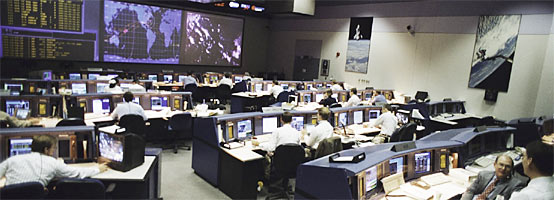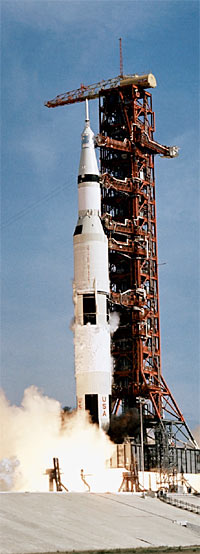|
By the
1990s the MCC was becoming outdated. Technology had moved on
from the 1960s technology that was supporting the center, but
the MCC continued its work until a state-of-the-art center
replaced it. The new MCC became operational in July 1995. That
original MCC is now a national monument.

An overall view from the rear
shows activity in the new Mission Control Center, opened for
operation and dedicated during the STS-70 space shuttle
mission.
Mission
operations have matured significantly over the years. Mercury
had begun with a fairly simplistic aircraft flight operations
approach. The process matured during the Gemini operations
when a systems handbook and direct interface between flight
control teams and the crew provided real-time ground-to-air
interactions. During Apollo, the operations teams worked
together on all issues involving flight systems, flight
design, science and human operations.
The
shuttle era brought radical changes. Shuttle flights had
greater and more diversified capabilities and more
participants in terms of federal agencies, institutions and
even foreign nations. Shuttle design and construction involved
close support from the mission operations team. The shuttle
was built with the understanding that good flight operations
required something of a symbiotic relationship between the
human occupants and the machine.

The huge, 363-foot-tall Apollo 11 space
vehicle is launched from Pad A, Launch Complex 39,
Kennedy Space Center, at 9:32 a.m. (EDT), July 16,
1969. | Fewer operators
worked the MCC at JSC than in the days of the Apollo lunar
missions, but shuttle flight operations required a networking
of the support team composed of the flight control team and
the multipurpose support rooms with the payload operations
control centers located at JSC or elsewhere, including
Goddard. Shuttle flight control became much more streamlined
than during Apollo flights and depended on advanced
information systems and computer programs. The shuttle
required all new computer software--adjusted and reconfigured
for each mission. Mission planning for early shuttle missions
began three or four years in advance.
Today,
MCC activities take place in one of two Flight Control Rooms
(FCRs or "Fickers"), the White FCR (for shuttle operations)
and the Blue FCR (for station operations). Here flight
controllers, in performing their command/control and
monitoring functions, get information from console computer
displays or projected displays and coordinate with the crews.
FCRs use a generic platform that can support all U.S. flight
activities. FCRs also support simulations-mission dry runs in
which specific tasks may be rehearsed or potential problems
and solutions may be addressed.
With the
launch of Zarya, the first International Space Station
component, in November 1998, station flight controllers and
engineering support teams in Houston and Moscow began
operations. In the Blue FCR, since the launch of Zarya, to
this day and for many years to come, ISS flight controllers
conduct continuous joint ISS operations in conjunction with
their counterparts in the Russian Flight Control Room in
Korolev, Russia, a Moscow suburb.
The ISS
presented new challenges. It is a multinational program with
partners from around the globe. Many of these partners
participate in the planning and execution of real-time
operations. Thus people in the Mission Control Center must
interface with their counterparts located in control centers
around the world. The Spaceflight Control Center in Korolev is
where the Russian flight controllers support operations of the
Russian elements of the space station.
"Because
many of the key ISS functions, including attitude control and
life support, are provided by the Russian segment, timely
interaction between the control centers in Houston and Moscow
is very important to ISS operations. Our ability to interact
and communicate with our Russian colleagues is critical to
safe and successful ISS operations," said Mark Kirasich, a
NASA space station flight director. |





